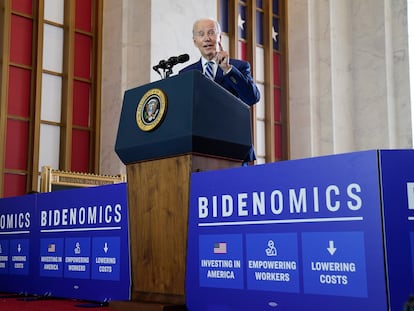US economic growth last quarter is revised up sharply to a 2% annual rate
Despite higher interest rates, the economy grew at a 2% annual pace from January through March

Showing surprising resilience in the face of higher interest rates, the U.S. economy grew at a 2% annual pace from January through March as consumers spent at the fastest pace in nearly two years.
Thursday’s revised figure from the Commerce Department sharply upgraded its assessment of first-quarter growth from its previous estimate of a 1.3% annual rate.
Despite the uptick, the government’s third and final report on January-March economic growth still marked a deceleration from the 2.6% annual rate from October through December and the 3.2% growth from July through September. The economy has been slowed by the Federal Reserve’s aggressive drive to tame inflation through a series of interest rate hikes beginning early last year.
Yet Thursday’s report on the nation’s gross domestic product — the total output of goods and services — showed why the economy has so far managed to defy expectations of a coming recession: Consumers continue to spend despite ever-rising borrowing costs. Their spending, which fuels about 70% of the economy, rose at a 4.2% annual rate in the January-March quarter, the most since April-June 2021.
A surge in petroleum and other exports also contributed to the upgraded estimate of growth during the first quarter. The economy managed to expand at a decent pace even though a cutback in business inventories shaved 2.1 percentage points off the quarter’s growth rate.
The Fed has raised its benchmark interest rate 10 times since March 2022 in its attack on inflation, which hit a four-decade high of 9.1% last year but has since slowed to 4%. The central bank’s rate hikes have led to higher costs for mortgages, auto loans, credit cards and business borrowing and widespread predictions that an economic downturn is inevitable.
But the economy has proved unexpectedly durable. Retail sales rose last month despite pressure from still-high inflation and rising borrowing costs. Government reports have shown recent gains in new-home sales and orders for long-lasting manufactured goods. And employers have added a healthy average of 314,000 jobs a month so far this year, with the unemployment rate, at 3.7%, still close to a half-century low.
In another sign of the job market’s continuing durability, the Labor Department reported that the number of Americans applying for unemployment benefits fell last week by 26,000 to 239,000.
In the current April-June quarter, the economy is believed to be slowing further but still managing to maintain its growth. Economists surveyed by the data firm FactSet have estimated that annual growth for the quarter will amount to 1%.
“While the economy has outperformed expectations, our base case is that the lagged and cumulative effects of restrictive (interest rates) will slow the pace of activity going forward,” Rubeela Farooqi, chief U.S. economist at High Frequency Economics, said in a research note.
Sign up for our weekly newsletter to get more English-language news coverage from EL PAÍS USA Edition
Tu suscripción se está usando en otro dispositivo
¿Quieres añadir otro usuario a tu suscripción?
Si continúas leyendo en este dispositivo, no se podrá leer en el otro.
FlechaTu suscripción se está usando en otro dispositivo y solo puedes acceder a EL PAÍS desde un dispositivo a la vez.
Si quieres compartir tu cuenta, cambia tu suscripción a la modalidad Premium, así podrás añadir otro usuario. Cada uno accederá con su propia cuenta de email, lo que os permitirá personalizar vuestra experiencia en EL PAÍS.
¿Tienes una suscripción de empresa? Accede aquí para contratar más cuentas.
En el caso de no saber quién está usando tu cuenta, te recomendamos cambiar tu contraseña aquí.
Si decides continuar compartiendo tu cuenta, este mensaje se mostrará en tu dispositivo y en el de la otra persona que está usando tu cuenta de forma indefinida, afectando a tu experiencia de lectura. Puedes consultar aquí los términos y condiciones de la suscripción digital.
More information
Archived In
Últimas noticias
Most viewed
- Sinaloa Cartel war is taking its toll on Los Chapitos
- Oona Chaplin: ‘I told James Cameron that I was living in a treehouse and starting a permaculture project with a friend’
- Reinhard Genzel, Nobel laureate in physics: ‘One-minute videos will never give you the truth’
- Why the price of coffee has skyrocketed: from Brazilian plantations to specialty coffee houses
- Silver prices are going crazy: This is what’s fueling the rally










































